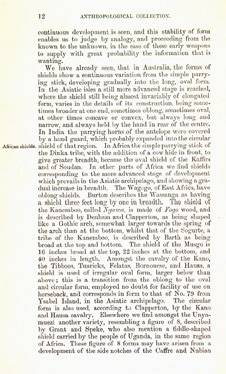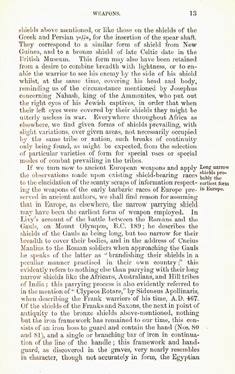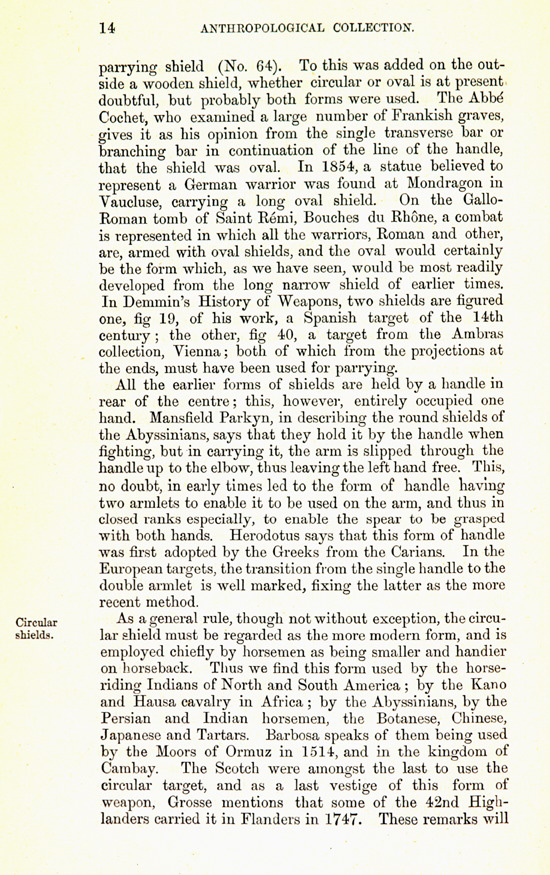| Form of the earliest European shields
|
The question as to the form of the earliest shields used in Europe is open to controversy. The earliest known shields are those of bronze, attributed to the bronze period, which are found occasionally in England, Scotland and Wales, and less frequently on the continent, though specimens of this class have been found in Denmark and Italy. They are round, from 9 in. to 13 in., and 22 in. in diameter, with umbos in the centre for the hand, the flat part being usually ornamented with concentric rings. It does not, however, by any means follow from this, that the circle was the earliest form adopted for shields in Europe, though some of this form may have been used during the bronze period. |
| Shields of the bronze period
|
Shields of the late Celtic period, dating, according to Mr. Franks,
from about 200 or 100 B.C., have been found in England, of long
oval form, specimens of which, from the Thames and Witham are
in the British Museum, and long shields of the same from are seen
on the arms of horsemen on some of the British coins. In 1847,
a circular centre piece of the same period, and having similar
ornamentation, was found in the Thames, and is figured in Horae
Ferales, showing evidence, by its rivets, of having been fastened
to a shield, which may possibly have been of wood or some perishable
material, and probably of the same oval or oblong form as the
others of the same date. The more perishable parts of shields
of this period would long since have decayed, leaving only the
centre pieces and the bosses, or such as were constructed entirely
of metal. Strabo says that the Rhoxolani used shields of rough
bull's hide, but wood and wicker work, as we have seen above,
must also have been used to a great extent, and of such materials
no trace would remain. The negroes of the Gold Coast, amongst
whom many antique forms are preserved, are described by Bosman
in the year 1700, as having long oblong shields of osiers 4 ft.
to 5 ft. long, and 3 ft. broad, with centre pieces and corners
of copper, "which they use with great dexterity, playing and parrying
with them in the left hand." For the sake of lightness these would
be preferable for ordinary purposes to such as were composed entirely
of copper or bronze; and these bronze ones of the late Celtic
period found in England, from the elaborate ornamentation upon
them, and their extreme rarity, must no doubt have been the shields
of the chiefs only. We may be certain, however, that no nation
ever suddenly adopted a weapon of new and unusual form, unless
it was copied from strangers. Where the weapon is indigenous the
fashion always varies gradually, so that a continuous development
is seen, and this stability of form enables us to judge by analogy,
and proceeding from the known to the unknown, in the case of these
early weapons to supply with great probability the information
that is wanting.
|
| African shields
|
In Africa the simple parrying stick of the Dinka tribe, with the addition of a cow hide in front, to give greater breadth, became the oval shield of the Kaffirs and of Soudan. In other parts of Africa we find shields corresponding to the more advanced stage of development which prevails in the Asiatic archipelago, and showing a gradual increase in breadth. The Wagogo, of East Africa, have oblong shields. Burton describes the Wassanga as having a shield three feet long by one in breadth. The shield of the Kanemboo, called Ngawa, is made of Fogo wood, and is described by Denham and Clapperton, as being shaped like a Gothic arch, somewhat larger towards the spring of the arch than at the bottom, whilst that of the Sogurte, a tribe of the Kanemboo, is described by Barth as being broad at the top and bottom. The shield of the Musgu is 16 inches broad at the top, 22 inches at the bottom, and 40 inches in length. Amongst the cavalry of the Kano, the Tibboos, Tuaricks, Felatas, Bornouese, and Hausa, a shield is used of irregular oval form, larger below than above; this is a transition from the oblong to the oval and circular form, employed no doubt for facility of use on horseback, and corresponds in form to that of No. 79 from Ysabel Island, in the Asiatic archipelago. The circular form is also used, according to Clapperton, by the Kano and Hausa cavalry. Elsewhere we find amongst the Unya-muezi [possibly should be Unyamuezi] another variety, resembling a figure of 8, described by Grant and Speke, who also mention a fiddle-shaped shield carried by the people of Uganda, in the same region of Africa. These figure of 8 forms may have arisen from a development of the side notches of the Caffre and Nubian shields above mentioned, or like those on the shields of the Greek and Persian yerron [alternatively, ierron, 'a type of shield'], for the insertion of the spear shaft. They correspond to a similar form of shield from New Guinea, and to a bronze shield of late Celtic date in the British Museum. This form may also have been retained from a desire to combine breadth with lightness, or to enable the warrior to see his enemy by the side of his shield whilst, at the same time, covering his head and body, reminding us of the circumstance mentioned by Josephus concerning Nahash, king of the Ammonites, who put out the right eyes of his Jewish captives, in order that when their left eyes were covered by their shields they might be utterly useless in war. Everywhere throughout Africa as elsewhere, we find given forms of shields prevailing, with slight variations, over given areas, not necessarily occupied by the same tribe or nation, such breaks in continuity only being found, as might be expected, from the selection of particular varieties of form for special uses or special modes of combat prevailing in the tribes. |
| Long narrow shields probably the earliest form in Europe
|
If we turn now to ancient European weapons and apply the observations
made upon existing shield-bearing races to the elucidation of
the scanty scraps of information respecting the weapons of the
early barbaric races of Europe preserved in ancient authors, we
shall find reason for assuming that in Europe, as elsewhere, the
narrow parrying shield may have been the earliest form of weapon
employed. In Livy's account of the battle between the Romans and
the Gauls, on Mount Olympus, B.C. 189; he describes the shields
of the Gauls as being long, but too narrow for their breadth to
cover their bodies, and in the address of Cneius Manlius to the
Roman soldiers when approaching the Gauls he speaks of the latter
as "brandishing their shields in a peculiar manner practised in
their own country;" this evidently refers to nothing else than
parrying with their long narrow shields like the Africans, Australians
and Hill tribes of India; this parrying process is also evidently
referred to in the mention of "Clypeos Rotare," by Sidoneus Apollinaris,
when describing the Frank warriors of his time, A.D. 467. Of the
shields of the Franks and Saxons, the next in point of antiquity
to the bronze shields above-mentioned, nothing but the iron framework
has remained to our time, this consists of an iron boss to guard
and contain the hand (Nos. 80 and 81), and a single or branching
bar of iron in continuation of the line of the handle; this framework
and handguard, as discovered in the graves, very nearly resembles
in character, though not accurately in form, the Egyptian parrying
shield (No. 64). To this was added on the outside a wooden shield,
whether circular or oval is at present doubtful, but probably
both forms were used. The Abbé Cochet, who examined a large number
of Frankish graves, gives it as his opinion from the single transverse
bar or branching bar in continuation of the line of the handle,
that the shield was oval. In 1854, a statue believed to represent
a German warrior was found at Mondragon in Vaucluse, carrying
a long oval shield. On the Gallo-Roman tomb of Saint-Rémi, Bouches
du Rhône, a combat is represented in which all the warriors, Roman
and other, are, armed with oval shields, and the oval would certainly
be the form which, as we have seen, would be most readily developed
from the long narrow shield of earlier times. In Demmin's History
of Weapons, two shields are figured one, fig 19, of his work,
a Spanish target of the 14th century; the other, fig 40, a target from the Ambras
collection, Vienna; both of which from the projections at the
ends, must have been used for parrying. All the earlier forms of shields are held by a handle in rear of the centre; this, however, entirely occupied one hand. Mansfield Parkyn, in describing the round shields of the Abyssinians, says that they hold it by the handle when fighting, but in carrying it, the arm is slipped through the handle up to the elbow, thus leaving the left hand free. This, no doubt, in early times led to the form of handle having two armlets to enable it to be used on the arm, and thus in closed ranks especially, to enable the spear to be grasped with both hands. Herodotus says that this form of handle was first adopted by the Greeks from the Carians. In the European targets, the transition from the single handle to the double armlet is well marked, fixing the latter as the more recent method. |
| Circular shields
|
As a general rule, though not without exception, the circular
shield must be regarded as the more modern form, and is employed
chiefly by horsemen as being smaller and handier on horseback.
Thus we find this form used by the horse-riding Indians of North
and South America; by the Kano and Hausa cavalry in Africa; by
the Abyssinians, by the Persian and Indian horsemen, the Botanese,
Chinese, Japanese and Tartars. Barbosa speaks of them being used
by the Moors of Ormuz in 1514, and in the kingdom of Cambay. The
Scotch were amongst the last to use the circular target, and as
a last vestige of this form of weapon, Grosse mentions that some
of the 42nd Highlanders carried it in Flanders in 1747. These
remarks will enable the reader to appreciate the following forms,
and to fill up in imagination the gaps which are wanting to complete
a continuous history of the shield.
[After this point the catalogue lists and describes circular shields from various localities and gives more general information about umbos and European shields in medieval times] |



